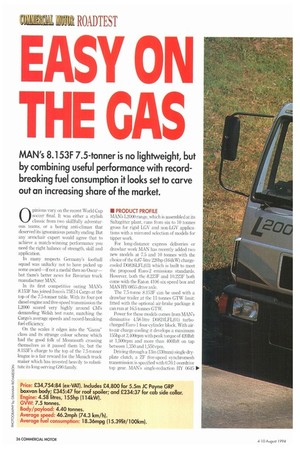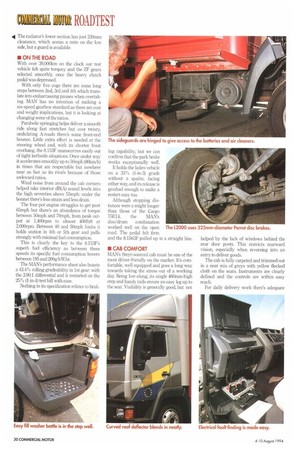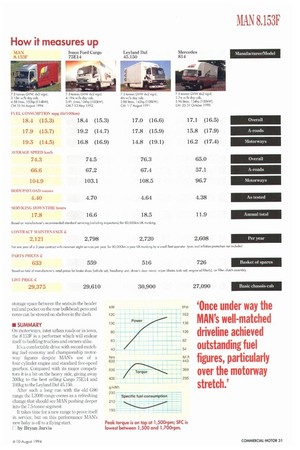EASY ON THE GAS
Page 28

Page 30

Page 32

Page 33

If you've noticed an error in this article please click here to report it so we can fix it.
MAN's 8.153F 7.5-tonner is no lightweight, but by combining useful performance with recordbreaking fuel consumption it looks set to carve out an increasing share of the market.
0 pinions vary on the recent World Cup soccer final. It was either a stylish classic from two skillfully adventurous teams, or a boring anti-climax that deserved its ignominious penalty ending. But any armchair expert would agree that to achieve a match-winning performance you need the right balance of strength, skill and application.
In many respects Germany's football squad was unlucky not to have picked up some award—if not a medal then an Oscar— but there's better news for Bavarian truck manufacturer MAN.
In its first competitive outing MAN's 8.153F has joined Iveco's 75E14 Cargo at the top of the 7.5-tonner table. With its four-pot diesel engine and five-speed transmission the L2000 scored very highly around CM's demanding Welsh test route, matching the Cargo's average speeds and record-breaking fuel efficiency.
On the scales it edges into the "Gazza" class and its strange colour scheme which had the good folk of Monmouth crossing themselves as it passed them by, but the 8.153F's charge to the top of the 7.5-tonner league is a fair reward for the Munich truck maker which has invested heavily to substitute its long-serving G90 family. • PRODUCT PROFILE MAN's L2000 range, which is assembled at its Saltzgitter plant, runs from six to 10 tonnes gross for rigid LGV and non-LGV applications with a mirrored selection of models for tipper work.
For long-distance express deliveries or drawbar work MAN has recently added two new models at 7.5 and 10 tonnes with the choice of the 6.87-litre 220hp (164kW) chargecooled D0826LFL(03) which is built to meet the proposed Euro-2 emissions standards. However, both the 8.223F and 10.223F both come with the Eaton 4106 six-speed box and MAN HY-08,55 drive axle.
The 7.5-tonne 8.153F can be used with a drawbar trailer at the 11-tonnes GTW limit: fitted with the optional air-brake package it can run at 16.5 tonnes GTW.
Power for these models comes from MAN's diminutive 4.58-litre D0824LFL(01) turbocharged Ettro-1 four-cylinder block. With airto-air charge cooling it develops a maximum 155hp at 2,400rpm with peak torque of 4201bft at 1,500rpm and more than 4001bft on tap between 1,350 and 1,550 rpm.
Driving through a 13in (330mm) single dryplate clutch, a ZF five-speed synchromesh transmission is specified with 0.76:1 overdrive top gear. MAN's single-reduction HY 0645 P. drive axle with 3.90:1 differential gives a geared top speed of 71mph (114km/h) with a gradeability of 43.4% (1-in-2.3). For fast touring there's an optional 3.45:1 diff which has an 80mph (129km/h) potential in exchange for reduced hill climbing ability Like its competitors MAN has adopted parabolic springing but with progressive acting rubber inserts at the front and anti-roll bars with hydraulic dampers all round. Air suspension (two-bellow ECAS) over the drive axle is among MAN's long list of options, along with a larger capacity compressor: a Meaclzone sleeper-cab conversion is available for £1,750.
Another change for L2000s is the 325mm diameter ventilated Perrot disc brakes at the front with traditional large-diameter drums at the back. There's load sensing on each axle, a standard air dryer and—to satisfy 92/97EEC noise regs—silencers on the full-air system with sound-absorption panels on the bottom of the engine.
To help streamlining the three-man day cab has an integral roof deflector while the L2000's low-torsion chassis has tubular crossmembers and no protrusions above the frame. Mounting brackets are also supplied; in this case they took a JC Payne GRP box van body featuring twin load-restraint rails, 230mmdeep kick panels and a Henderson wide-slat shutter.
• PRODUCTIVITY
The 8.153F does not have things all its own way when it comes to streamlining. Among our previous test vehicles in this class were the Cargo 75E14 with a sleek Marshall/Ecotek combination; a Mercedes with a contoured Vaile body system; and the Leyland Daf FA45.150 with a shapely Boalloy Van dry freighter.
While the 8.153F can't match the Cargo 75E14's option of a six-pot engine operators shouldn't put off. As Ivecu has shown, the four-cylinder diesel's lower weight more than compensates for any reduction in power and torque. In any event, the charge-cooled MAN unit is not short of either.
What with the endless motorway repairs and roadworks, few 7.5-tonners manage to maintain maximum speeds for long and not many carry a full payload. With a full tank the MAN's 4.4-tonne body/payload is a sniff ahead of a Mercedes 814 but at least 250kg heavier than the Cargo or Leyland-built 45Series Once under way, however, the MAN's wellmatched driveline achieved outstanding fuel figures, particularly over the motorway stretch.
In dry sunny weather across the M4 section its 19.5mpg (14.51it/100km) at an average 65.2mph (104.9kmill) is way ahead of the pack. Only the 45150's 67.4mph (108.5km/h) is quicker and its speed was paid for with consumption of 14.5mpg (19.11it/100km).
The MAN's not bad over the A-roads either, returning a useful 17.9mpg (15.71it/100km) at a steady 41.4mph (66.6kin/h). Its overall average of 18.36mpg (15.39 lit/100km) at 46.2mph (74.3km/h) promises commendable productivity
Typical users of these flying machines are the express parcels and rental companies who demand maximum usage with minimum downtime. In this demanding environment the MAN's 15,000km service intervals will soon come round, and this reflects in its annual servicing time. By way of comparison Iveco and Mercedes have 30,000km periods (with special long-drain oil); the Leyland Daf 45.150 has a 20,000km interval.
The MAN's £29,375 price tag is 1235 below that of the Cargo 75E14 and £700 cheaper than the 45-Series but all three are considerably more than the Mercedes' 127,090. To its credit MAN's annual service contract is cheaper than the rest but its basket of parts costs more.
There's no ducking under the front panel to carry out daily checks: the washer bottle is in the cab step; engine oil and water dips are behind the cab—if a cab side collar is added provision must be made for access to theni.1' The radiator's lower section has just 230mm clearance, which seems a mite on the low side, but a guard is available.
• ON THE ROAD
With over 39,000km on the clock our test vehicle felt quite torquey and the ZF gears selected smoothly, once the heavy clutch pedal was depressed.
With only five cogs there are some long steps between 2nd, 3rd and 4th which translate into embarrassing pauses when overtaking. MAN has no intention of making a six-speed gearbox standard as there are cost and weight implications, but it is looking at changing some of the ratios.
Parabolic springing helps deliver a smooth ride along fast stretches but Over twisty, undulating A-roads there's some front-end bounce. Little extra effort is needed at the steering wheel and, with its shorter front overhang, the 8.153F manoeuvres easily out of tight kerbside situations. Once under way it accelerates smoothly up to 50mph (80km/h) in times that are respectable but nowhere near as fast as its rivals because of those awkward ratios.
Wind noise from around the cab corners helped take interior dB(A) sound levels into the high seventies above 55mph: under the bonnet there's less strain and less drain.
The four-pot engine struggles to get past 65mph but there's an abundance of torque between 50mph and 70mph, from peak output at 1,400rpm to almost 400Ibft at 2,000rpm. Between 40 and 50mph limits it holds station in 4th or 5th gear and pulls strongly with minimal fuel consumption.
This is clearly the key to the 8.153F's superb fuel efficiency as between these speeds its specific fuel consumption hovers between 195 and 200g/kW.hr.
The MAN's performance sheet also boasts a 43.4% rolling gradeability in 1st gear: with the 3.90:1 differential and it restarted on the 25% (1-in-4) test hill with ease.
Nothing in its specification relates to brak
ing capability, but we can confirm that the park brake works exceptionally well.
It holds the laden vehicle on a 33% (1-in-3) grade without a qualm, facing either way, and its release is gradual enough to make a restart easy too.
Although stopping distances were a might longer than those of the Cargo 75E14, the MAN's disc/drum combination worked well on the open road. The pedal felt firm and the 8.1563F pulled up in a straight line.
II CAB COMFORT
MAN's Steyr-sourced cab must be one of the most driver-friendly on the market. It's comfortable, well equipped and goes a long way towards taking the stress out of a working day. Being low-slung, its single 460mm-high step and handy rails ensure an easy leg up to the seat. Visibility is generally good, but not helped by the lack of windows behind the rear door posts. This restricts rearward vision, especially when reversing into an entry to deliver goods.
The cab is fully carpeted and trimmed out in a neat mix of greys with yellow flecked cloth on the seats. Instruments are clearly defined and the controls are within easy reach.
For daily delivery work there's adequate storage space between the seats,in the header rail and pocket on the rear bulkhead; pens and notes can be stowed on shelves in the dash.
• SUMMARY On motorways, inter-urban roads or in town, the 8.153F is a performer which will endear itself to budding truckies and owners alike.
It's a comfortable drive with record-matching fuel economy and championship motorway figures despite MAN's use of a four-cylinder engine and standard five-speed gearbox. Compared with its major competitors it is a bit on the heavy side, giving away 300kg to the best selling Cargo 75E14 and 240kg to the Leyland Oaf 45.150.
After such a long run with the old G90 range the L2000 range comes as a refreshing It takes time for a new range to prove itself in service. but on this performance MAN's new baby is off to a flying start.
C by Bryan Jarvis






















































































